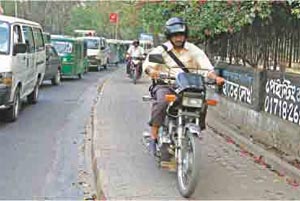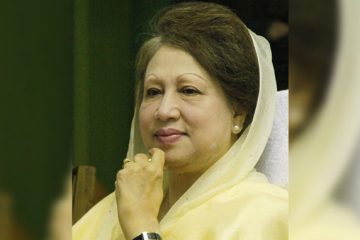HC asks govt to ensure walkways only for walkers
 The government has to stop straying of vehicles, particularly motorcycles, on to footpaths and walkways in the capital, the High Court said yesterday.
The government has to stop straying of vehicles, particularly motorcycles, on to footpaths and walkways in the capital, the High Court said yesterday.
The order came along with other directives, including removal of all billboards that darken foot bridges.
The Dhaka Metropolitan Police commissioner and Dhaka City Corporation (north and south) administrators will take action about the billboards within 30 days of receiving the order, the court said.
The High Court issued the directives in response to two separate writ petitions filed as public interest litigation seeking directives upon the government to ensure free movement of people and safe operation of vehicles in the city.
The authorities will have to mark zebra crossings on streets near Matsya Bhaban, High Court Mazar Gate, Jatiya Press Club and Institute of Engineers, Bangladesh in 15 days, it said.
It also directed a deploying of adequate traffic police at the crossings.
The authorities must submit separate comprehensive reports on the number of motor vehicles operating in the city, total area of streets, pathways, walkways and foot bridges in the capital by April 10.
At the same time, the DMP commissioner was directed to submit the notifications, if issued earlier, restricting rickshaw operations in Dhaka city over the last one year, Deputy Attorney General Amit Talukder told The Daily Star.
The HC ordered the Bangladesh Road Transport Authority chairman to submit a report on the number of registered motorised vehicles plying the city.
The HC bench of Justice Mohammad Bazlur Rahman and Justice Md Habibul Gani also issued rules upon the authorities to explain in four weeks why directives should not be given to them to ensure unhindered movement of people in the city.
In the rules, it asked the communications secretary to explain why he should not be ordered to constitute Dhaka Metropolitan Transport Authority which will regulate and coordinate the public and mass transport system.
The government was also asked to explain why it should not be directed to arrange sufficient segregated pathways for pedestrians and non-motorised vehicles and to remove all the obstacles for free movement of people through the existing walkways.
Two Supreme Court lawyers — KM Zabir and Aynun Nahar Siddiqua — filed the two petitions in August and October last year on the basis of media reports on sufferings of people while moving in the city.
The HC heard expert opinions of Prof Sarwat Jahan, a teacher of Bangladesh University of Engineering and Technology, who presented a study report prepared by Japan International Cooperation Agency in 2010 on vehicles plying in Dhaka.
Citing the study, he said rickshaws are more useful than private cars in terms of occupying space.
Against the 40 percent of road space they require, rickshaws transport almost 54 percent of passengers, while cars taking up 39 percent of road space, transport less than 9 percent passengers, Prof Sarwat said.
“It is thus clear that cars, not rickshaws, are the main culprit,” he said.
He said bicycles use 1.7 percent of road space but transport 2.5 percent passengers; buses occupy only 6 percent of space but transport 28 percent passengers, baby taxies (auto-rickshaws) 10 percent of space but carry only 4 percent of passengers, he said.
The communications secretary, home secretary, inspector general of police, administrators of DCC North and DCC South, deputy commissioner of DMP (traffic) and its joint commissioner, and Bangladesh Road Transport Authority chairman have been made respondent to the orders and the rule.
Advocate ABM Waliur Rahman Khan appeared for the petitioners.
Courtesy of The Daily Star




















